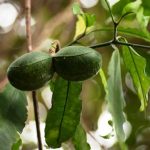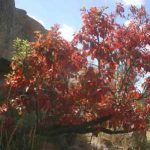TREE LIFE
January 2000
MASHONALAND CALENDAR
Saturday 1st January 2000. Mark’s Walk is to Domboshawa, one of our favourite spots. Take the Borrowdale Road out of Harare, pass through Domboshawa village, and beware of speed humps, pedestrians, animals and bad drivers. Turn right at ±33 km peg at the large Domboshawa Caves sign. We will meet in at the car park at 2.30 p.m. On our last visit the entrance fee to this site was $5.
Tuesday 4th January. Botanic Garden Walk at 4.45 for 5 p.m. where we will meet Tom in the car park and continue with the Euphorbiaceae family. There will be a guard for the cars.
Sunday 16th January. The Tsindi Ruins (formerly known as the Lekkerwater Ruins) are southeast of Harare not far from Marondera on a prominent granite hill. From excavations made in the 1960s it appears that the first walls of the settlement were built in the 13th century and were added to in the 15th century. They are of the same type as those found at Great Zimbabwe. During the 17th or 18th century 2 large clay huts were built within the enclosure; it is believed they were used for ceremonial purposes. We can expect to see some uncommon (for Harare residents) species namely – Diospyros whyteana, Olinia vanguerioides, Schrebera alata, Apodytes dimidiata, Cussonia natalensis and Solanecio mannii.
Saturday 22nd January. Mark’s second walk this month will be at Christon Bank at the Botanical Garden Extension. The turning to the right is about 22 km out of Harare on the Mazowe Road. Meet at 2.30 p.m. in the car park which is at the end of the very twisty road, about 7 km from the turn off.
28th January to 1st February. The campsite at Mapor Estates in Odzi has been reserved for us for the 5 days. This is a delightful spot as well as being really exciting botanically. Please let Maureen Silva-Jones know by no later than 10th January if you would like to be part of this group so that final arrangements can be made. Tel: 755750 (w) 740479(h) or 011719601 (cell).
Tuesday 1st February. Botanic Garden Walk.
MATABELELAND CALENDAR
Saturday 1st January 2000. We will have our New Year Social on January 1st at Jonathan’s house, 3 Rue des Fleurs, Fortunes Gate, Bulawayo. Because Jonathan will be away until a day or so beforehand, Gill Short will be handling most of the arrangements. Folk should contact her on tel. 41541(h) or 65942 (w) for further details.
NYARUPINDA CATCHMENT
The Scene
On 6th October the first rains of summer fell gently, bringing relief and pleasure, the smell of wet dust, soaked earth and washed leaves; a renewal of zest for the great outdoors. October ‘99 had 13 days as compared with 18 days in October ‘98 when temperatures were above 30º C. Towards the end of that month a peaceful Sunday afternoon ended with a tempest and hailstones being blown this way and that across Tinto hill! The draught within the house held the doors fast, each of us was alone at opposite ends of the building waiting for the worst to be over. The rain gauge only caught 8 mm, precipitation was horizontal. Miombo woodland was wind-pruned and some large branches came down. The whole of the next day was spent barrowing away the debris, sorting it for fuel wood and compost. A metre-long gash of stripped bark faces the dining room, poor Mnondo; it needs a dressing of colour matched acrylic paint to hide this wound. Masked and Red-headed Weavers’ nests on adjacent branches of Tipuana shading the top lawn withstood the tossing they got. A Brubru’s nest in the same tree disappeared; this was found recently among the spent flowers of St. John’s Wort, Hypericum sp. nearby. The lowest branch of this Brazilian Rosewood bears a resettled epiphytic orchid salvaged from a storm-damaged Mufuti last year, it has latched on to the anastomosing bark. It now bears two pure white scented flowers with 13 cm long spurs, which resemble the late Dick Petheram’s photograph of Aerangis verdickii, which featured on BOC’s calendar a few years ago. Some observations have been noted on the growth of this orchid since it has been at eye-level close to the house; when the rains begin, its aerial clinging roots become filled with water and turn green, especially at their tips. Towards the end of the summer, growth slows down as the water is used up, air takes its place in these aerial root sheaths and they lose their green colour and appear white during the dry winter, there is also shrinkage of the root tips. This is a pleasant way to learn some physiology of epiphytes. The writer would have enjoyed attending the recent seminar on orchids held at the National Herbarium in Harare.
A Surprise Event, Visitors from South Africa
A Protea Atlassing Workshop on 6th November at James and Ann Sinclair’s farm Serui Source near Norton was announced in Tree Life No. 237.
The day began with introductions all round, then Tony Rebelo, the team spokesman and initiator of the Protea Atlas Project told us how it all began at the Botany Department at University of Cape Town. It was “on the road” by January 1990; the Australians gave permission for their Banksia Atlas to be the basis for the Protea Atlas Project. Modifications have been made for Southern African objectives and conditions; the Manual works well once the codes are understood and their application practiced in the field. This sharpens the powers of observation in selecting the most likely option, and not to be afraid to leave a field blank on the Sight Record Sheet from which the facts are computerised. All participants in the Workshop received gratis an Atlassing kit consisting of Protea Atlas Manual, Field Notebook and a pad of more than 40 Sight Records Sheets. These are no good without a map of suitable scale; we were given a photocopy of the map of Serui Source, scale 1: 50,000, it is on part of two maps as so often happens. Proteaphiles recommend using the 1: 250,000 topographical series, at this scale 2 cm = 5 km. The former scale is 2 cm = 1 km.
Protea Atlassing is broadly described as consisting of three processes: Identifying a Protea, Understanding its Ecology, Map reading. Its purpose in South Africa is the collecting of information on the distribution and status of members of Proteaceae so as to construct a database which will inform veld management into the next century. Data shows that new species are still being located and many range extensions have been recorded. It will be very interesting to read about the results of the Atlassing Team’s visit to E. Districts, Chimanimani and Bulawayo. It is hoped that a summary will appear in Tree Life.
This information had time to sink in as Ann Sinclair led us to her field (orchard as it is called ‘down south’) of proteas for the flower markets here and overseas, mainly Holland. The enclosure resembled a typical seedbed site for tobacco narrow raised beds supplied with drip irrigation. A sizeable Banksia tree was at the entrance to the plantation; there were King and Queen Proteas, Leucadendrons, literally white/silver trees; these are cone-bushes which can be 2 m high. Pincushions are Leucospermums, literally white seeds; these shrubs have many prominent teeth at the apex of their leaves that surround the stem of each single pincushion inflorescence. Spider-bushes have divided foliage, Blushing Bride Spider-head is a popular market flower, its genus is Surraria. Some bushes seemed to be only vegetative; these provide variously coloured tips of greenery used as fillers in floral arrangements.
The diagnostic features of the two most popular and distinctive of the proteas worldwide are as follows: King Protea Protea cynaroides has a long leafstalk in contrast to the Queen Protea Protea magnifica, which has obovate stalkless leaves and flower tips elongated into a cone in the centre of the flowerhead.
Hands on Atlassing with the Experts
A sandveldt walk was led by Ann and Tony Rebelo, the flat terrain supported woodland on deep, grey soil many hectares in extent, so it was easy to choose a 500 m diameter circle of homogeneous, i.e. uniform, habitat for the first Record Locality. It was centred from the first Protea species found, this was Protea gaguedi coded PR GAGU. In this half kilometre circle Protea angolensis, Protea welwitschii and the dreaded subject of hybrids confronted us. Tony told us how to record this so as not to upset data-collection by the computer. This is where the Additional Remarks box helps the Atlas Coordinator check all the information on the Sight Record Sheets (SRS). Mervyn, a fulltime ecologist, scouted the Record Locality finding enough PR GAGU for Widespread to describe the Population Size. The group of staff from the National Herbarium was diligent filling in Proteas Present throughout the morning’s practical work. Alien species have to be recorded, the culprit was Jacaranda. Whilst Atlassing observers notice other trees of interest because of flowers or fruit, one of these was Swartzia with flowers plentiful; later in the day the ground was covered in pods below another Snake Bean Tree at the other side of the farm. Mental notes were made of these distractions; there was a vast recumbent yet upright Violet Tree, which was the cue for those people with cameras to take pictures of the girls in the party in front of scented Securidaca.
Mapping Proficiency
This depends on a thorough understanding of Locality Resolution Code which is on p. 20 of the Manual. Somehow my choice here was approved until Ivan Massyn came to be Coordinator, he preferred code 3 instead of code 1 for use with the 1: 50,000 map; this had been selected from the table at the foot of the page. Unfortunately, there was no time for this to be explained at the Workshop Day. As a lone Atlasser pioneer in Zimbabwe in 1992 and for some years, there was no local expert to advise me, thus began a lively correspondence with Tony Rebelo and Chris Leerens, who painstakingly answered questions. On one occasion six pages of animated annotated drawing came from the former person. He remembered these pictures when he saw them again at the Sinclairs, his companions commented on his handwriting. It has improved on account of all his illustration in PAN, meaning the quarterly newsletter of the Protea Atlas Project; these are amusing and botanically correct. Frequently quizzes are based on his drawings, answers appear in the edition that follows. This way of learning keeps us on the ball. Thanks to both of you for your help.
Tea on the verandah was a great reviver after quite a lot of walking since lunch time. On the table there was a basket of Protea family exhibits; a silky paired inflorescence but, multiple infructescences of Protea welwitschii the Honey-scented Protea; wood showing the speckled grain and general lack of growth rings. Hakea from Australia is the exception. Furry spikes of Faurea speciosa and a Globe Artichoke. During the morning Tony had told us the story of the milk bucket that leaked. He referred to the use of Grevillea robusta wood for furniture, fittings and cooperage – casks and milk buckets. Unfortunately, the medullary rays in Proteaceae wood are porous, this is their way of connecting all separate living cells in the radial plane in a tree trunk and its branches; lenticels in the bark allow oxygen and other gases to diffuse inwards via the air spaces between ray cells. Rays tap the xylem for water with minerals in solution and receive soluble nutrients made in the leaves; simple sugars are used for growth and storage. Only wood with the finest of rays could be used to contain liquids, such species as English Sycamore or African Kirkia acuminata.
The Atlas Coordinator
Val Charlton is on the staff of the National Botanical Institute, Kirstenbosch, she was one of the visitors, and it was a pleasure to meet this warm, caring person who leads the Atlassing Project. She is a sun-loving lady with a memorable décolletage.
The Project’s new address is as follows:
Protea Atlas Project, Conservation Biology Unit NBI. P Bag X7, Kirstenbosch 7735 Cape Town.
The Globe Artichoke
This thistle-like plant has the same generic name as the specific name of King Protea, Cynara and cynaroides respectively. Tony said Cynara and Mervyn said cynaroides, which means like Cynara. Kyon is a dog in Greek, the involucral bracts of this Protea and those of the globe artichoke are likened to the teeth of a dog. End of story.
Ann prepared a lunch of home grown salads, quiche and cheese, this augmented the picnic items brought by everyone, we thank Ann and James Sinclair for their hospitality in that delightful old thatched house – the family seat.
Wishing you blessings in AD 2000.
-Benedicta Graves Raffingora 27-11-99
BAT MIRROR
After reading Ian Riddell’s note in Tree Life No 238 (December 1999), a check in DJ Mabberley’s The Plant Book (1993) showed that there is no genus Macuna, and Ian Riddell was right in wondering whether it was a misspelling of Mucuna in the New Scientist article of November 1997. Mabberley also mentioned that there are bat-pollinated species of Mucuna (Papilionoideae) in both the Old World and the New World. Presumably one could identify these by the presence of a petal in each flower shaped like a concave mirror. According to Mabberley the irritant hairs of the pods of some species of Mucuna were formerly used as a vermifuge, and my dictionary tells me that a vermifuge is “any drug or agent able to destroy or expel intestinal worms”. Using Buffalo Bean to get rid of worms would be pretty drastic treatment, don’t you think? Some people would rather keep the worms and get rid of the Buffalo Bean!
Lyn Mullin.
GALLOWAY FARM NORTON, Sunday 21st November 99
The morning dawned grey and wet, which may have put some people off venturing out.
They were the losers as it turned out to be a perfect day for treeing. Cool, cloudy and dry, with the deeply mulched ground soft and damp underfoot.
Maureen Riley, our host, was there to greet us and organise a gate guard and to lead us across the black vlei on grassy tracks, as the newly graded roads were slippery. Galloway is to be split up into 5 hectare plots for low density housing. Hopefully someone with a good sense of conservation will buy the plots, which include this wonderful island of trees on a rocky outcrop. We marked 54 trees on the list plus several shrubs and creepers, not to mention bulbs in flower and ferns and fungi.
The outcrop was granite with several termitaria with an intrusion of dolerite surrounded by black clay soils.
The wood has unusually large trees, suggesting a very good water source. It must have been untouched by fire or cultivation for a very long time.
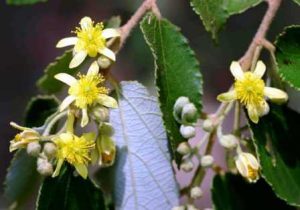
Grewia monticola. photo: Bart Wursten. Source: Flora of Zimbabwe.
A number of plants were in flower, notably Jasminum multipartitum with striking white flowers. Grewia monticola with bright yellow flowers. Vitex payos the Chocolate Berry Tree with its small white and mauve flowers and new leaves unfurling. The leaves are five-foliate and covered in tawny brown hairs.
Large specimens included Brachystegia spiciformis, Erythrina abyssinica, and Kirkia acuminata whose wood is yellowish in colour and is soft and light but difficult to work because of silica crystals. It polishes well and a lot of the wooden carvings on offer to tourists are Kirkia. Afzelia quanzensis is a beautiful hardwood with a distinctive bark. The petiolules on each leaflet twist and there is a yellow rim round each leaflet. Afzelia will not grow in a plantation but thrives living in solitary state.
There were several Dalbergia melanoxylon, the Zebrawood, a straggling tree with fresh green distinctive heart-shaped leaves with parallel veins. The wood is used for bag pipes and other wind instruments; it is purple in colour and darkens with oxidation as it ages.
On the south side towards the edge of the wood was a cluster of huge Combretum collinum. This is referred to as the Rhodesian Bushwillow and is not found further south than Gauteng.
Beyond this the country opens out and had been cultivated and Terminalia sericea is now taking a stand. The wood of Terminalia sericea is used to make yokes and pick handles. Fencing posts last well as they are resistant to termites.
There were a wealth of new plants pushing through the well mulched ground, which included many Albizia amara whose rounded leaflet tips distinguish in from Albizia harveyi.
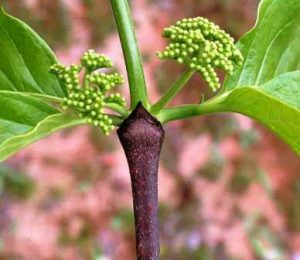
Canthium lactescens . Photo: Rob Burrett. Source: Flora of Zimbabwe
We saw very few large specimens though. Canthium lactescens is very prevalent, mostly small trees with shiny green curled leaves. Allophylus africanus looked settled among the rocks with its fluted grey green bark and velvet leaves.
On the north side of the wood we found a very large Dombeya rotundifolia lying on its side but still growing vigorously. Andy found Euphorbia espinosa, which is not usually found in this area. It normally occurs on Kalahari sands on the edge of mopane country. The leaves were new and petioles pink and the peeling coppery bark very distinctive.
There is a clearing in the middle of the wood which is used for gatherings and church services, so there is evidence of people-pressure and someone is collecting rocks – there were piles on the edge waiting for collection.
Thank you Maureen for suggesting that the Tree Society visit this lovely wood.
-Ann Sinclair.
MWENJE DAM, SUNDAY 17 OCTOBER 1999
Mwenje Dam was constructed in the late 1960s to enhance the supply of water for irrigation and industrial use in the Glendale area. The Murowodzi River backed behind the wall forms part of the boundary of Chiweshe and the Glendale district, the lake now considerably larger as the wall was raised in the early 1980s, an impressive sight with the curved concrete spillway and long rock-lined wall.
Some of the original mature woodland remains, with some substantial specimens of Combretum collinum providing welcome shade in the car park. This is a species often overlooked for various reasons, however, some of the more obvious features are the bark is pale and flaky and the branches have a droopy effect. Although new leaves have yet to develop some of the characteristic features, the “haphazard” positions (opposite / sub opposite / alternate) give a clue, furthermore the heavy concentration of scales on the leaf underside is also worth noting. On the fringe of the embankment a large Mobola Plum Parinari curatellifolia supports a shady environment below and here Apodytes dimidiata (this looks out of place in dry Miombo woodland), Ficus sur, Pittosporum, the spiny climber Capparis tomentosa and the well naturalized Cedrela toona are found. Mark showed how to separate Carissa edulis from Carissa bispinosa. By using a lens, it was noticed that the petals of Carissa edulis overlap each other to the right; the quick ID of using the variance in the forked spines is not a reliable guide. The spines and ripening fruit provided some light relief!
Some distance away from the dam wall the woodland is more open with some really mature specimens of Msasa, and although a hot and dry October morning the sweet scent of the last of the Msasa flowers hung on the warm air. John Wilson pointed out the enormous thicket of Dichrostachys cinerea – tall enough to walk under with little vegetation below and as the seeds are palatable for stock, the problem of bush encroachment increases. Other tree species worth mentioning here are Albizia versicolor – this has the largest leaflets of this genus with a big gland at the base of the rachis; and Piliostigma thonningii, supporting in its forked trunk, a large colony of the Leopard Orchid – Ansellia africana.
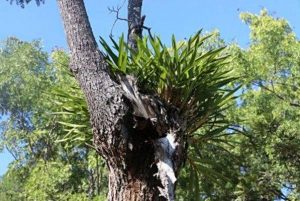
Ansellia africana.. Photo: Mark Hyde. Source: Flora of Zimbabwe
A number of exotics have naturalized here, Cedrela toona being very common, with an unexpected find of Dalbergia sissoo close to the water’s edge. This is an attractive species originally from Asia and the colour and general shape of the tree is the first indicator of a ‘foreigner’, and on closer examination, it is easy to see that the alternate leaflets are almost round to elliptic with a really pronounced attenuate (drip) trip. In spite of being past peak flowering time the few remaining tiny yellow flowers produce a sweet scent and some immature small flat seed pods were appearing.
Even though the roads in the area have changed since our last trip it was heartening to note that members are capable of finding their way to a site, even though the signs were not yet in place – perhaps the Tree Soc. signs are a luxury after all!
-A. MacNaughtan
RED MAHOGANY IN HARARE
Although the indigenous Red Mahogany Khaya anthotheca, is an environmental exotic in Harare, it has been fairly commonly planted as an ornamental tree in the City, and there is one quite outstanding specimen growing in the garden of Number 77 Mendel Road, in Avondale. The tree was planted in the rainy season of 1917-18 by one, James McLauchlin, who was farming there. It was first measured in December 1971, when its height was 25.6 metres and its diameter 116.8 cm. By February 1973 the diameter had increased to 121.9 cm, by July 1976 to 129.5 cm, and by March 1982 to 143.5 cm.
In March 1987 the height of this tree was 28 metres, and the diameter 153.7 cm. The trunk forked at about 5 metres above ground level, and the crown diameter was 27 metres. A piece of wire protruding from the trunk was all that remained of an old clothes line that had been supported by the tree years before. It was quite evident that the growth of the tree had been good and steady during the first 70 years of its life, and the owners of the property at that time, Mr and Mrs. RJ Burisch, were so intent on preserving the tree that they had demolished the old homestead and built a new house further away from it.
There was another fine specimen of Red Mahogany in the courtyard of Katanga Court in Selous Avenue, Harare, between Third and Fourth Streets, but it became too large for the courtyard and was removed sometime after March 1982. It was planted by a Mrs Osler in the rainy season of 1925-26, and like the tree in Mendel Road, its growth was monitored over a number of years. When last measured in March 1982 it was 23 metres tall and had a bole diameter of 114.3 cm.
These two examples show how well-meaning people can all too easily be overtaken by their tree-planting zeal! Species that grow to very large sizes are generally better as street trees, and should be used only with great discretion in most urban gardens.
-Lyn Mullin
AERIAL BOMBARDMENT TO REFOREST THE EARTH
Forests are to be created by dropping millions of trees out of aircraft. Equipment installed in the huge D-130 transport aircraft, used by the military for laying carpets of landmines across combat zones, has been adapted to deposit the trees in remote areas.
An idea, originally from a former RAF pilot, Jack Walters, has been developed by the US manufacturer Lockheed Martin Aerospace so that 900,000 young trees can be planted in a day.
A company set up to market the idea, Aerial Forestation Inc, of Newton, Massachusetts, believes that companies with polluting power-plants will be forced by governments to plant forests to offset the global warming effect of the carbon dioxide they emit. Planting via the C-130s will halve the cost of manual methods.
Peter Simmons, from Lockheed, said: “Equipment we developed for precision planting of fields of landmines can be adapted easily for planting trees.”
“There are 2,500 C-130 transport aircraft in 70 countries, so the delivery system for planting forests is widely available – mostly mothballed in military hangers waiting for someone to hire them.”
“The possibilities are amazing. We can fly at 1000 ft at 130 knots planting more than 3,000 cones a minute in a pattern across the landscape – just as we did with landmines, but in this case each cone contains a sapling.
That’s 125,000 trees for each sortie and 900,000 trees in a day.”
The tree cones are pointed and designed to bury themselves in the ground at the same depth as if they had been planted by hand. They contain fertilizer and a material that soaks up surrounding moisture, watering the roots of the tree.
The containers are metal but rot immediately so the tree can put its roots into the soil.
Moshe Alamaro for Aerial Forestation said “A man on the ground can plant 1,000 trees a day. If we are going to combat global warming by collecting carbon in the wood of trees, we will want millions of them a year. Airborne planting is probably the only way.”
Mr Alamaro believes that the system will work in any area that used to contain trees, and even in desert areas where the cones can be adapted to plant suitable shrubs. He has a pilot project planned for the Sinai desert in Egypt.
Areas which could be forested again are: in the Scottish mountains where the hills are bare, large areas of the Black Forest cut down during the cold war to provide “line of sight” across the iron curtain between East and West Germany, North Africa, the tundra of Canada, Australia and the US. In five years he believes that his company could be planting a billion trees a year enough to reforest 3,000 square miles.
Paul Brown. Environment Correspondent
The Guardian. September 2 1999.
NOTES FROM THE LAY-BYS
A family wedding in late August took Anne and me to Victoria Falls by road, our first look at the Kalahari sand forests of north-western Zimbabwe for more than eleven years.
Zambezi Teak
The first thing that struck me was the encouraging sign of seedling regeneration of Zambezi Teak Baikiaea plurijuga. The last time I was up that way (April 1988) I was depressed about the apparent absence of seedling teak, especially in the Mbembesi Forest Area, and it seemed to me that the teak there had been exploited beyond any possibility of recovery. Now there seems good cause for hope.
In the Gwayi Forest Area, further along the road, I noted patches of dense teak regeneration in places, and not just along the roadside, either. Saplings 1-3 metres tall were visible 50 metres or more into the forest, and presumably well beyond that. The teak has not yet completely lost its leaves, so there was no possibility of misidentification. Gwayi always was a better part of the forest, and the greater preponderance of regeneration in this area was not unexpected.
Mukwa
The sad news is that “Mukwa wilt disease” continues to take its toll, and I saw signs of widespread deaths all along the road from Mbembesi to Fuller Forest Areas, i.e. from about the 80 km marker all the way to Victoria Falls. The fungus responsible for the deaths seems to be Fusarium oxysporum, first noted around Livingstone in Zambia in 1958, and reported from the Victoria Falls region of Zimbabwe in 1964. A recent Forestry Commission report indicates that, by the end of the next century, large-diameter Mukwa, Pterocarpus angolensis, will be down to only seven percent of the 1992 numbers in the Kalahari-sand forests.
There is a similar situation (but a different fungus, Phytophthora cinnamomi) in the Jarrah (Eucalyptus marginata) forests in the southwest of Western Australia. There the problem has been associated with a rise in the water table resulting from the heavy exploitation of the forests in the late 19th and early 20th centuries. As far as I know a similar link has not been established for the Mukwa problem in the Kalahari-sand forests, but perhaps Jonathan Timberlake would like to comment on this. Our Mukwa in the northwest is in serious peril, so if you have any Mukwa furniture in your home, treasure it and hang on to it.
The Victoria Falls Rainforest
My perception of the rainforest on this visit was that there were more dead trees opposite the Devil’s Cataract than I remembered from 1988, and the increase in deaths was undoubtedly due to the very low river levels (and consequent reduction of spray) during the droughts of 1988-1996. On our recent visit we found the river still quite high, and we were lashed with spray for most of the mile-long length of the Falls. We even felt the spray in the car park. In 1988 you could get to see the Falls – and the rainforest – for free. Today it costs you $50 if you produce your Zimbabwean ID, but a visitor to the country has to pay US$20 (nearly ZW$800).
-Lyn Mullin
Cladostemon kirkii – according to David and Sally Johnson in Gardening with Indigenous Trees & Shrubs, can be recommended as one of the finest of all small ornamental trees. Anthon Ellert has been able to germinate several and is offering them for sale at $75. Contact Maureen Silva-Jones to reserve one. The Ellerts come to Harare from Bulawayo in early Jan. and will bring them then.
ANDY MACNAUGHTAN CHAIRMAN


